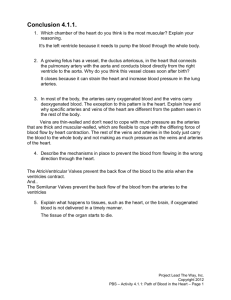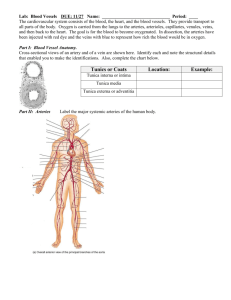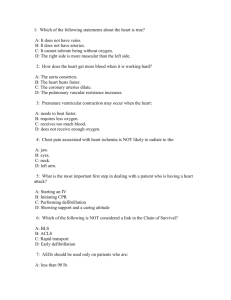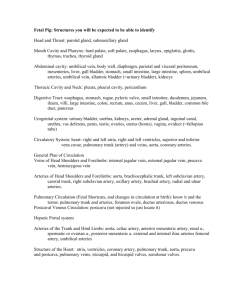Fetal Pig Anatomy Review _Advanced
advertisement
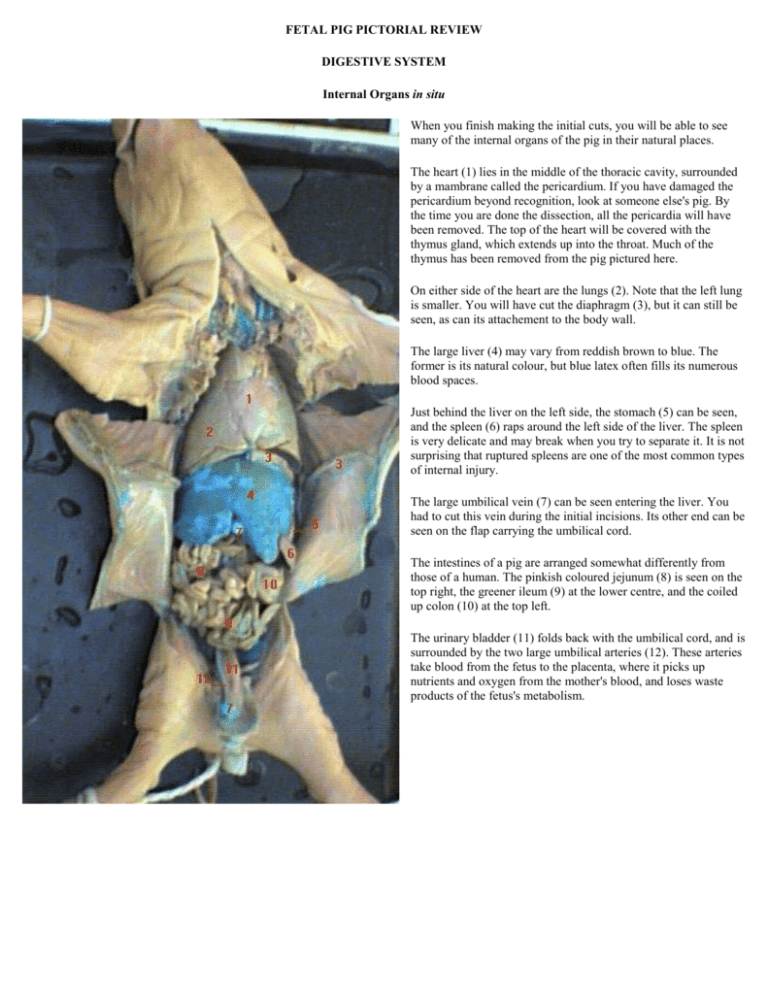
FETAL PIG PICTORIAL REVIEW DIGESTIVE SYSTEM Internal Organs in situ When you finish making the initial cuts, you will be able to see many of the internal organs of the pig in their natural places. The heart (1) lies in the middle of the thoracic cavity, surrounded by a mambrane called the pericardium. If you have damaged the pericardium beyond recognition, look at someone else's pig. By the time you are done the dissection, all the pericardia will have been removed. The top of the heart will be covered with the thymus gland, which extends up into the throat. Much of the thymus has been removed from the pig pictured here. On either side of the heart are the lungs (2). Note that the left lung is smaller. You will have cut the diaphragm (3), but it can still be seen, as can its attachement to the body wall. The large liver (4) may vary from reddish brown to blue. The former is its natural colour, but blue latex often fills its numerous blood spaces. Just behind the liver on the left side, the stomach (5) can be seen, and the spleen (6) raps around the left side of the liver. The spleen is very delicate and may break when you try to separate it. It is not surprising that ruptured spleens are one of the most common types of internal injury. The large umbilical vein (7) can be seen entering the liver. You had to cut this vein during the initial incisions. Its other end can be seen on the flap carrying the umbilical cord. The intestines of a pig are arranged somewhat differently from those of a human. The pinkish coloured jejunum (8) is seen on the top right, the greener ileum (9) at the lower centre, and the coiled up colon (10) at the top left. The urinary bladder (11) folds back with the umbilical cord, and is surrounded by the two large umbilical arteries (12). These arteries take blood from the fetus to the placenta, where it picks up nutrients and oxygen from the mother's blood, and loses waste products of the fetus's metabolism. Digestive Organs Beneath the Liver By pushing the liver (1) up toward the head, you will be able to view many of the organs of the digestive system. The gall bladder (2) is usually quite evident as a sort of blister on the third lobe of the liver. The next page looks at it more closely. The stomach (3) is easily identified as a large floppy pouch under the left lobe of the liver. The duodenum (4) arches away from the stomach to the pig's right. A deep crease indicates the location of the pyloric sphincter (5). If you probe this area, you will be able to detect the strong muscular nature of this sphincter. The spleen (6) lies just beow the stomach, and is attached to it by a thin membrane. You may have to break this membrane to see deeper structures. The three major parts of the intestine, the jejunum (7), the ileum (8) and the colon (9) are still visible . Gall Bladder and Surrounding Organs The gall bladder (1) is a soft sack embedded in the liver. In this view, with the liver turned back, you can just make out the attached ducts, the cystic duct (2) which drains the gall bladder, the hepatic duct (3) which carries bile from the liver to the gall bladder, and the common bile duct (4) which carries the bile from both organs to the duodenum (5). A person can live without the gall bladder, because the livert can drain bile directly into the duodenum, but a special restricted diet is required, since bile cannot be stored up for a large fatty meal. Now you see the same view with the membranes removed. This makes the ducts much more obvious. It also clearly shows the hepatic portal vein (6), which runs parallel to the common bile duct. Viewing the Pancreas The pancreas can be viewed by pulling the bottom of the stomach up toward the head. It will be necessary to break some of the membranes holding the stomach and spleen in place. Use a blunt probe for this. The pancreas (P) is a long, loosely organised gland, that has often been described as looking like a "bunch of grapes". If you look carefully, you may be able to find the pancreatic duct, which goes behind the duodenum (D) and joins the common bile duct before it enters the duodenum. Intestine and Caecum Role the intestines to the pig's right to see the view shown here. Trace the path that food would take as it moves through the intestine. If you like, you may try ot tease out the intestine toi see how long it is. To do this, you will have to trim the mesentery carefully. Make sure you are completely familiar with its structure before you destroy it. The jejunum (1) appears pinky in most fetal pigs. Remember that the fetus is not swallowing anything except a bit of amniotic fluid, so there is little in the intestine. The liver is secreting some bile. By the time the intestinal juices get to the ileum (2) some of the water has been absorbed and the bile is more concentrated. This makes the ileum look greenish. The ileum ends where the small intestine meets the colon (3) a a "T" junction. The other end of the "T" (4) is the caecum. Note that the caecum is large compared to the human appendix, but small compared to the pig's horse-like relatives. The pig is descended from herbivores whose caecum was undoubtedly vital for digeting cellulose, but, like ourselves, it has become an omnivore and gets little if any nutrition from cellulose. In this diagram, you can also see the bottom of the rectum (slightly out of focus below the caecum) as it passes between the umbilical arteries on its way to the anus. make sure you trace the full length of the rectum on your pig. Intestinal Mesenteries Close Up The intestines are held in place by a pair of membranes called the mesenteries (1). The mesenteric arteries run between these parallel membranes, and give rise to a vast number of tiny arteries (2) that take blood to the jejunum and ileum. These in turn break up into the thousands of arterioles that supply the villi and help to absorb food. Near the base of the mesenteries is a row of white, fatty-looking bumps. These are lymph nodes on the lymph ducts that drain the lacteals. Since you take so much foreign material into your gut, it makes sense that you should have a strong line of defense against any invading microorganisms that might escape the digestive processes. RESPIRATORY SYSTEM Organs of the Chest Cavity (Thorax) in situ To open the thoracic (chest) cavity, you will have to cut through the cartilage of the breast bone, and the collar bones. Try not to damage the underlying blood vessels as you do. When you first open the chest cavity, your view will be dominated by the heart (1) and lungs (2,3). Usually, the right lung (2) will be larger than the left (3), though that is not obvious in the view shown here. Each lung consists of several lobes. The heart may be covered (or partly covered) by a transparent membrane, the pericardium, seen here almost intact. The chances are, you will have destroyed much of it while opening the chest. Feel the inside of the rib cage and the surface of the lungs with a gloved finger. They are very smooth and slippery, due to the presence of thin, moist membranes, the pleura. The pleura allow the lungs to slide across the walls of the thoracic cavity with almost no friction during inhalation and exhalation. Note the diaphragm (5) between the lungs and the liver. Remember that you cut the attachments of the diaphragm to the body wall during the initial cuts. If you have a small pig, the diaphragm may look like a translucent membrane with muscle fibres just beginning to grow into it from the edges. If your pig is older, it will be a definite layer of muscle, as shown here. Covering the top of the heart is part of the thymus (6), an important component of the fetal immune system. thymus tissue extends well up into the throat, and must be carefully picked away to see other features of the cervical region. The prominent thyroid, an endocrine gland, is visible as a brick red or slightly purplish round mass. Trachea and Lungs (Heart Removed) The view shown here is one that you will not have, since it required removal of the heart. You will need the heart in place for the next part of the dissection. By moving it around and looking behind it, however, you should be able to see many of the features shown here, and perhaps to understand them in context a bit better. The cavity in which the heart sat is seen between the two lungs (1). The muscles, glands and membranes have been peeled away from the front of the trachea (2) which clearly shows the rings of cartilage that keep it open. The trachea branches into several main bronchi (3), of which three are visible here. The stumps of pulmonary arteries and veins are also visible (4). Note that the colour of these vessels is not a reliable guide to their identity; you would be better to note whether they attach to the left atrium (veins) or the right ventricle (arteries). Close up of the trachea and bronchi Detail of Bronchi and Bronchioles This piece of lung has been scraped repeatedly with the back of a blunt probe, wearing away the solid tissue. The image was taken using a 20X dissecting microscope. The network of tiny airways is clearly visible, as are a few of the numerous blood vessels. A few bubbles of carbon dioxide have formed where bronchioles are ruptured. Note that the lungs of a fetal pig have not been inflated, and would not contain much in the way of gases. All gas exchange at this point is taking place thorugh the placenta. Interior of Mouth By cutting through the sides of the jaw, you can open the mouth wide enough to view the structures at the back. The ridged hard palate (1) is one of the most obvious features, grading into the soft palate (3) of the pharynx. Small "milk teeth" (2) are already erupted in the mouth. The large and muscular tongue (4) has been pulled forward and down in this picture. Papillae, which contain the taste buds, are visible, especially along the edge. At the back of the tongue is the epiglottis (5) which fits into an opening from the nasopharynx (6), alllowing direct passage of air from the nose to the trachea. During swallowing, the epiglottis is pulled down to cover the entrance to the trachea, allowing food to pass over it to the oesophagus. Depending on the position of your cut, you may be able to see the maxillary salivary glands (7). Vocal Cords and Epiglottis In this view, the tongue has been pulled far forward and down, causing the epiglottis (1) to pull out of the nasophrynx (4). The opening to the larynx and trachea is clearly visible, as is one of the cartilaginous vocal cords (2) that stretch across it. Vibrating vocal cords and the resonance of the larynx beneath them create sounds. Just behind the opening of the larynx is the opening of the oesophagus (3) CIRCULATORY SYSTEM Circulation in the Fetal Pig The following pages will show you the major blood vessels of the fetal pig, as they appear in real specimens. The pages are sequenced in the order in which you would find the various vessels as you dissected. You may access them in a different order by clicking below. Use this page to improve your understanding, and to study. Note that the blood vessels in these pigs have been injected with red (arteries) and blue (veins) latex. The larger arteries have very thick walls and may appear white. Some vessels may fail to receive latex. The left carotid artery and the left jugular vein have been opened to allow injection of the latex, and may be broken or distorted. Veins Anterior to the Heart The veins draining the head and arm regions are quite symmetrical. Internal(1) and external(2) jugular veins drain each side of the head and join to form the left and right common jugulars(3). These are joined by left and right subclavian veins(4) respectively to form the short left and right innominate veins(5) the two innominates join to form the anterior vena cava(6) which drains into the right atrium(7) of the heart. These veins serve to bring deoxygenated, nutrient poor blood back from the front end of the pig. In the right atrium it is mixed with the deoxygenated nutrient-rich blood from the posterior vena cava(8). The blood then enters the right ventricle and is pumped to the lungs for oxygenation. Remember, however, that the lungs in a fetal pig are not yet functional, so oxygen must be acquired in the placenta. You will see the mechanism for this in a later view. In the next step, these veins must be removed to see the underlying arteries. Arteries above the Heart Blood is pumped from the left ventricle through the aorta(1), which is visible behind the pulmonary artery. As the aorta arches to the left side of the pig (your right, remember) it gives rise to two major arteries (in humans it would be three). The larger brachiocephalic artery(2) gives rise first to the right subclavian artery(3) and then to the right carotid(4) and left carotid arteries(5). In humans the left carotid has its own branch directly from the aortic arch. The second branch from the aorta is the left subclavian, which feeds the left arm and shoulder. All of these arteries carry oxygenated blood under high pressure to anterior systems of the pig. Arteries of the Heart The heart is a very complex organ, especially in a mammalian embryo. In the fetal pig, the right(1) and left(2) atria are clearly visible as thinwalled sacs on the top of the heart. The right(3) and left(4) ventricles are fused into one muscle mass, but their positions can be inferred from the shape of the heart. This view of the heart clearly shows the coronary arteries(5) radiating over the wall of the heart muscle. The arteries arise from the very base of the aorta, and coronary veins (no latex) return blood to the right atrium. The pulmonary artery(6) rises from the right ventricle on the ventral side of the heart, and arches back over the heart, where it branches to take blood to each lung. Because the lungs are not yet functional in a fetus, it would be wasteful to send huge amounts of blood to an organ that is not fulfilling any purpose. A short broad shunt vessel, the ductus arteriosus(7), takes blood from the pulmonary artery and diverts it into the aorta(8). The heart rolled to the right to show the ductus: This shunt must close at birth, to separate the systemic and pulmonary circulation. It then atrophies to become a small ligament, the ligamentum arteriosum, that holds the pulmonar artery and aorta together in the adult. Failure of the ductus to close is called a patent ductus, and requires surgery in some children to tie off the vessel. The aorta itself arises from the left ventricle, dorsal to the pulmonary artery. It arches over to the left and back, travelling down behind the left side of the heart along the backbone. Veins of the Heart Area The venous system of the heart is quite simple. The numerous pulmonary veins leaving each lung merge to become the four main pulmonary veins(1), which enter the left atrium. Sometimes the heart must be twisted around to see these. Some of you will have destroyed some of the pulmonary veins when removing a lung, but the points of entry should still be visible on the heart itself. The much larger venae cavae(2) enter the right atrium. The anterior and posterior vena cava merge right at the point where they enter the heart. The posterior vena cava which travels along the backbone, parallel to the aorta, passes right through the liver and diaphragm before entering the heart. The coronary veins(3) are particularly clear on this specimen. They can be seen conecting to vena cava. Posterior Arteries of the Systemic Circulation By removing the left lung and rolling the heart to the right, you can see the aorta as it descends through the diaphragm. It gives rise to small intercostal arteries that feed the muscles of the chest. After it has passed through the diaphragm, it gives rise to two moderate sized arteries. These can bge seen by rolling the abdominal organs to the right side of the pig, or removing some of the liver and intestines. The first, the coeliac(1) quickly branches into gastric, hepatic, splenic and pancreatic arteries that feed the upper alimentary organs. The second, the anterior mesenteric artery(2) gives rise to the hundreds of branches that fan out through the mesentery, taking blood to all the villi of the small intestine. Two large branches from the aorta, the renal arteries(3 - hard to see here), take blood to the kidneys for cleansing, and two small, thin gonadal arteries(4) branch off very close to them. A small artery then branches off the aorta and runs anteriorly along the rectum(5). this is the posterior mesenteric artery, which supplies the large intestine and picks up water in the colon. At the end of the aorta, it branches into four main trunks. Two go to the legs, the iliac arteries(6), while the other two go ventrally along the sides of the bladder and into the umbilical cord. These two umbilical arteries(7) are responsible for transporting metabolic wastes to the placenta and carrying nutrient poor and deoxygenated blood to the placenta where it may obtain required resources by diffusion from the mother's blood. Closer view Detail of the Base of the Aorta Veins of the Trunk Area Blood from the legs is drained by the large iliac veins(1), which merge to form the posterior vena cava(2). Small gonadal veins (usually not visible) and renal veins(3) join this large vessel, which travels forward through the liver and diaphragm to the heart. At the top of the liver, it is joined by the hepatic vein(4), which is usually buried right in the liver tissue. The posterior vena cava joins the anterior vena cava just as it enters the right atrium(5). Hepatic circulation The liver receives its oxygen from a small hepatic artery that branches off the coelic artery, but most of the blood flowing through the liver comes from the gut. All the blood delivered by the coeliac artery, the anterior mesenteric artery and the posterior mesenteric artery is collected into the large hepatic portal, which runs parallel to the common bile duct. Usually, the hepatic portal does not get injected with latex, so it can be difficult to see. After it enters the liver, the hepatic portal distributes blood to a vast network of sinuses in the liver, where it can be screened and its solutes adjusted. These sinuses are then drained by small veins which merge to form the hepatic vein. The hepatic vein, shown in the photo, was buried right in the tissue of the liver, and had to be dissected out. The hepatic vein then takes blood to the posterior vena cava. Interior of the Heart The two views of the dissected heart on the left show the organ before and after the latex was removed from the inner chambers. Try to identify the valves and chambers, and the entrances of the various blood vessels. Note that this is difficult to do in a two dimensional view. Take what you see here and try to apply it when you look at a real heart in the classroom. URITOGENITAL SYSTEM External views of male and female fetal pig Externally, the differences between male and female fetal pigs are small. There is no external penis in the male, and the scrotum is not well developed until sexual maturity. In females, the entrance to the vagina is hidden beneath the tail. The two specimens in this view show the small abdominal differences. The male (bottom) clearly shows the genital pore just behind the umbilical cord. This is the opening through which the erect penis will be everted for mating. Running back from the genital pore along the midline of the abdomen, a faint white line is visible. This is the internal penis. Slight development of the scrotum is visible between the legs. This is much clearer in the rear view, accessible by clicking at the end of this text. In the female (top) there is a lack of the above features. The main external feature is the genital papilla, a triangular flap of tissue that covers the opening of the urogenital tract. It is found just ventral to the anus, beneath the tail. Female Reproductive Organs of the Abdomen This close up view shows the primary reproductive organs of the female. The ovaries (1) are small kidney-shaped organs. They usually cover the fallopian tubes (2) which just show below the right ovary (left side!) in this view. In this view, showing the top end of the ovary (1), one can see the fallopian tube (2) terminating in the funnel-shaped funiculum (3). Note that the funiculum lies right next to the ovary, but is not attached. It must capture eggs released directly into the body cavity. Both the ovary and the fallopian tube are attached to the back wall of the abdomen by a strong ligament (4). The fallopian tubes bring ova to the uterine horns (3) which join in hte midline to form the uterine body (4). The uterus is thus "Y-shaped". This allows for the attachment of placentas for a whole litter of young pigs along the uterine horns. The ovary and uterus are held in place by the broad ligament (5), which later in life will have to bear most of the weight during pregnancy . The uterine body passes through the pelvic opening between the urethra (5), which drains the bladder (6), and the rectum (7). Female Urogenital Organs of the Pelvic Area The bladder (1), lies between the two umbilical arteries (2). In this view it is pulled over to the pig's right side. The left ureter (3), which drains urine from the kidney, can be seen entering the bladder The ovary (4) lies just posterior to the kidney (not visible in this view). The uterine horns (5) pass over the umbilical arteries and the ureters, and join to form the uterine body (or common uterus)(6) In this view, the pelvic canal has been dissected. The birth canal consists of the uterine body and the vagina (7). Urine leaves the body via the urethra (8). Note that, unlike in humans, the vagina and urethra join to form a short urogenital sinus (9) before reaching the outside. Abdominal Organs of the Male Urogenital System This view of the male abdomen, with the intestines held out of the way, shows some features common to both sexes. A tough membrane, still intact on the pig's left side, separates the urinary organs from the digestive ones. This membrane has been removed on the pig's right side (your left) to show the kidney (1), which extracts nitrogen and other waste from the blood. The kidneys are drained by the ureters (2) which carry urine to the urinary bladder (3) for storage. In this view, the bladder has been pulled back. In the intact animal, it would lie in front of the rectum. Note the umbilical arteries on either side of the bladder. After birth, these will atrophy and become ligaments connecting the aorta and the front wall of the abdomen. Little of the reproductive system can be seen in the abdomen. The testes, which originated in the abdomen, have been pulled down into the scrotum through the inguinal canal (5). All that can be seen are the vasa deferentia (sing. vas deferns), which emerge from the inguinal canal, pass over the ureters and umbilical arteries, and enter the urethra (not clearly visble) just after it leaves the bladder. Organs of the Male Reproductive System In this view the scrotum and inguinal canal on the pig's left side have been dissected. The testis (1) is clearly visible as a smooth oval body inside the scrotum. Over the past few weeks it has been pulled from its point of development in the abdomen through the inguinal canal and into the scrotum. It will continue to descend even further into the scrotum. It is pulled by a contraction of the gubernaculum, better seen in some of the alternative views. The top end of the epididymis (2) is visible. The epididymis consists of thousands of tiny tubes that collect mature sperm from the tiny cavities in the testis and store them until ejacualtion. The left vas deferens (3) can be seen ascending through the inguinal canal and passing over the umbilical artery. it will carry sperm to the urethra. The gonadal artery and vein run paralllel to it, as do very sensitive nerves (not visible). Any blocakge of the inguinal canal can cause sterility, pain, and varicose veins in the scrotum (varicocoele). The most common blockage is due to an inguinal hernia, in which a small bulge of the intestine is forced into the canal. Also visible in this view is the penis (4) which has been dissected out. Notice that it runs along the ouside of the pelvis to the anal area, where it meets the urethra that has descended through the pelvic canal. (not visible here) Organs of the Male Reproductive System - Deep Dissection By dissecting through the pelvic bones, one can see the deeper structures of the male tract. The urethra (2) drains the urinary bladder (1) and enters the penis (3), allowing urine to be moved out of the body. The urethra appears very thick at "2" because it is surrounded by strong muscles which control urinary flow and also contract during ejaculation. The left testis and epididymis are dissected out of the scrotum (6). The gubernaculum (7) has contracted to pull the testis into the scrotum. Sperm travel from the testis to the epididymis, which loops beneath the testis an meets the vas deferens (8). The vas runs through the inguinal canal, over the umbilical artery and ureter, and joins the urethra just below the bladder. Two sets of seminal galnds can be seen attached to the urethra, the seminal vesicles (9) and the bulbourethral gland (10). These add nutritive and protective fluids to the semen as it passes on its way to the penis The urethra (1) is now a narrow tube. Most of the volume of the penis is taken up by the corpus cavernosa (2), a spongy tissue that helps to erect the penis when it is engorged with blood. Two other erectile bodies, the corpora spongiosa run on either side of the urethra. They are not as clear in htis image. One of the arteries that provides blood to erect the penis is visible (3).


